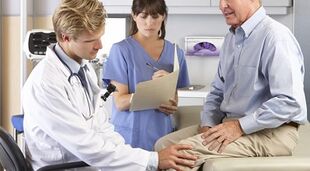
Osteoarthritis of the knee joint is also called gonarthrosis or deforming osteoarthritis. The disease can lead to serious consequences, including damage. At the first signs of gonarthrosis you should consult a doctor for diagnosis and treatment. Therapy should be completed in strict compliance with the conditions and other prescriptions.
General characteristics of the disease
Gonarthrosis is a progressive cartilage lesion covering the joint surface. As a result of such changes, the functionality of the joint is impaired and pain occurs.
Osteoarthritis deformity is chronic. In most cases, the disease progresses slowly, but certain factors can accelerate its progression. This refers mainly to the individual characteristics of the body, the activity and physical activity of the patient, concomitant pathologies.
Two terms are often confused - arthritis and osteoarthritis. These pathologies are similar in certain characteristics, but differ in the nature of the course. Only a specialist can make an accurate diagnosis and prescribe the appropriate treatment.
In gonarthrosis, the feeding mechanisms of cartilage are disrupted, so its function is gradually disrupted. Among arthrosis with different localization, the pathology of the knee joint occurs in every third patient.
Causes of primary osteoarthritis of the knee joint
This is the most common form of the disease. Elderly women are at risk of developing primary pathology, especially in the presence of overweight - obesity of 2 or 3 degrees.
It is believed that primary gonarthrosis is associated with life expectancy. Compared to previous centuries, it has increased significantly and the joints simply wear out over time.
Gonarthrosis associated with natural aging is considered normal. If the articular cartilage is destroyed earlier or this process is too intense, then this condition is considered pathological.
Causes of secondary osteoarthritis of the knee joint
Secondary gonarthrosis can be caused by the following factors:
- genetic predisposition, provided that it can be clearly traced;
- leg fracture;
- sprain of the knee joint;
- meniscus injury; congenital dysplasia of the knee joint;
- extreme physical activity (typical of athletes);
- constant static loads;
- rheumatism;
- rheumatoid arthritis (not to be confused with rheumatism);
- ankylosing spondylitis;
- congenital deformity of the lower extremities - valgus or varus;
- congenital shortening of one limb;
- metabolic syndrome;
- gout;
- acromegaly;
- osteomyelitis;
- chondrocalcinosis;
- pathologies related to material exchange;
- joint hypermobility - the ligament apparatus is inherently weak;
- hemochromatosis;
- diabetes mellitus;
- pathology of the endocrine system.
There are many possible causes of deforming osteoarthritis, so this pathology is called polyetiological. Often the exact cause of the disease cannot be determined, which is why primary (idiopathic) gonarthrosis is diagnosed.
Symptoms of gonarthrosis
In addition to pain (the main symptom), the pathology may be accompanied by the following symptoms:
- Break and click.These symptoms usually occur during movement and are often ignored by patients. Crunching in the knee can mean that grooves, osteophytes, ulcers have appeared on the joint surfaces.
- Restrained movements.This symptom is very important during the diagnosis, as it allows to distinguish gonarthrosis from a number of other pathologies that affect the musculoskeletal system. The movement is usually stiff in the morning. When a person starts walking, this symptom disappears within half an hour. If the stiffness lasts for an hour or more, it may mean an inflammatory process or other pathology.
- Reduced range of motion.This symptom suggests that the patient is unable to fully bend the knee. This is due to the pain syndrome, which softens the intensity of which a person tries to move his leg less. Over time, this leads to a shortening of the connections, which are called contractures.
- Silent connection.Gonarthrosis can lead to obstruction of the joint in a certain position and it is impossible to move due to severe pain. This usually occurs due to changes in the joint surfaces when the internal ligaments of the knee are pulled out, protruding from the pineal glands. In this case, only the reverse displacement of the ligament can help. Less commonly, the cause of joint congestion is the penetration of a foreign body into the joint space. The source of the problem may be part of the meniscus or a fragment of an osteophyte.
Classification of the disease
Each of the stages has specific characteristics:
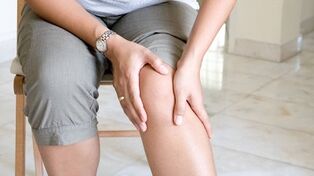
- The first stageis initial, also called easy. The first signs of pathology are considered to be its onset, and the transition to the next stage is characterized by the appearance of bone deformities. They can be detected by visual inspection or by X-rays. At the first stage of the disease, the accumulation of fluid in the joint begins - this phenomenon is called synovitis. It is he who causes pain, which so far appears only when moving. Their intensity can vary.
- In the second (moderate) stageof gonarthrosis, the pathological changes are visible even visually. They manifest themselves with an increase in the size of the knee, its deformation. On X-rays you can see that the bone tissue at the edges of the joint has grown and the joint space has narrowed. At this stage, the pain syndrome is manifested by the slightest load and when walking or squatting, the knee begins to crunch.
- The third (severe) stagedeforming osteoarthritis is diagnosed when there is virtually no cartilage in the joint. If the pathology is difficult, then the bones can grow together, which will lead to complete immobility of the affected limb.
The exact stage of gonarthrosis is determined by a specialist. In this case, you should focus not on the symptoms of the disease, but on the X-rays received. The pathology does not always follow the standard pattern.
Diagnostics
Only instrumental diagnostics will help determine deforming osteoarthritis:
- x-ray;
- ultrasound scan;
- tomography - computed tomography or magnetic resonance imaging;
- arthroscopy;
- thermography;
- scintigraphy.
Often an X-ray is enough to detect gonarthrosis. It is performed in two projections. If only one knee is affected, a healthy limb image is still taken to compare the results.
Which doctors should I seek help from?
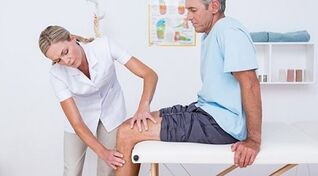
In the case of osteoarthritis deformities, various specialists may be involved. In a conventional clinic, they usually consult a surgeon.
Arthrologist, rheumatologist, orthopedist usually deal with problems with gonarthrosis. In addition, the involvement of a chiropractor, arthroscopist may be required. The treatment usually involves a physiotherapist, a physical therapy instructor, a masseur qualified in this field.
Treatment of gonarthrosis
The treatment for osteoarthritis of the knee takes a long time. In most cases, outpatient treatment is sufficient. This implies a whole range of measures. Treatment is based on drug therapy, physiotherapy and exercise. In some cases, surgery is required. In gonarthrosis is also allowed to use folk recipes, but they must be combined with traditional medicine.
Drug therapy
The use of various drugs is the main component of the treatment of gonarthrosis. Such a disease requires an integrated approach, suggesting the possibility of using the following drugs:
- Non-steroidal anti-inflammatory drugs.These drugs are produced in various forms, but for osteoarthritis are preferred tablets for oral administration, solutions for injection, means for external use in the form of creams, ointments, gels. Non-steroidal anti-inflammatory drugs not only fight inflammation but also reduce pain.
- Corticosteroids.Such drugs are usually resorted to when the disease is severe or drugs from the nonsteroidal anti-inflammatory group are ineffective. They are usually used as injections, injecting the medicine into a joint capsule. Corticosteroids are used as a symptomatic therapy to relieve inflammation and severe pain.
- Analgesics.The severity of the pain syndrome is taken into account when prescribing such drugs. If the pain syndrome is of high intensity, then they resort to strong opiates.
- Chondroprotectors.Thanks to these drugs, cartilage tissue is saturated with nutrients that stimulate cell growth. The effect of chondroprotectors is manifested for a long time, which is why they are used for long therapeutic courses. Such drugs are suitable for pathology of 1 or 2 degrees.
- Antispasmodics and muscle relaxants.Such drugs are needed when the pathology is accompanied by muscle spasms.
- Vasodilator drugs.Such drugs improve blood flow, relieve spasm of small vessels. The combination of vasodilators and chondroprotectors is effective because the cartilage tissue in this case is better saturated with nutrients.
- Warming ointmentsto improve blood circulation. Such agents are suitable in the absence of synovitis.
The medicine is prescribed by a doctor. Only he can determine what drugs are needed in each case, according to what scheme should be taken and how long should be the therapeutic course for each prescribed drug.
Physiotherapy
Various physiotherapeutic methods are actively used in deforming osteoarthritis. They are used for various purposes: to reduce pain, relieve inflammation, activate the blood supply and speed recovery.
The following physiotherapy methods are effective in osteoarthritis of the knee:
- Phonophoresis.This technique is an ultrasound therapy combined with the effects of drugs. Due to the high-frequency vibrations, the tissues of the knee joint heat up, which provides deeper penetration of drugs into them.
- Shock wave therapy.The procedure uses a special device that generates radial acoustic waves. Under their action, the blood supply in the periarticular area is activated, which stimulates the restoration of cartilage and bone structures.
- Ozone therapy.This procedure involves the use of active oxygen. It provides analgesic and anti-inflammatory effects on tissues.
- Electromyostimulation.This technique is often used during rehabilitation, as well as in the presence of contraindications to exercise. Under the influence of electrical impulses, muscle tone increases and blood circulation improves.
- Diathermy.This technique refers to electrotherapy and involves the use of high frequency high strength currents for deep heating.
- Cryotherapy.This technique is also called cold treatment. The affected area of skin is exposed to low temperatures for a short period of time. This method restores metabolic processes, increases blood circulation, reduces the severity of inflammation, eliminates pain, relieves muscle spasm.
- Hirudotherapy.This technique is considered an alternative. Leeches are placed around the affected joint. The procedure relieves pain, relieves swelling and stimulates regeneration.
- Laser therapy.This technique is usually used in the early stages of pathology. It provides anti-inflammatory, analgesic and stimulant effects.
- Plasma therapy. This procedure is also called joint plasmalifting. Includes intra-articular injection. They use the patient's own blood plasma, which is saturated with platelets. This procedure relieves inflammation, promotes the regeneration of cartilage tissue.
- Healing baths- turpentine, radon, hydrogen sulfide.
- Acupuncture.Such a procedure is usually resorted to in the initial stages of the pathology. This technique relieves swelling, eliminates pain and allows you to restore joint mobility.
exercise therapy
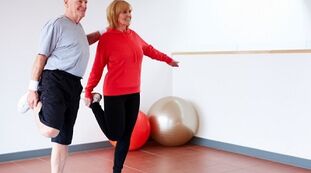
Physiotherapy is needed for gonarthrosis. The various exercises should be monitored by a qualified professional. The main goal of exercise therapy is to restore the mobility of the joints and to achieve a certain range of motion. It is also necessary to increase strength and muscular endurance.
Exercise therapy is not used during periods of disease exacerbation. At this time the joint needs rest and maximum relief. Locomotor activity is allowed when the inflammation and pain are relieved, at least 5 days should pass from that moment.
The exercise program should be developed individually for each patient. It is necessary to take into account the peculiarities of the course of the disease, the degree of its severity, the individual characteristics of the patient.
Gymnastics
At home, a patient with gonarthrosis can do some exercises on their own. You have to do it in stages - first you have to warm up, then do strength exercises and finish with stretching.
The heating is performed as follows:
- Place your feet shoulder-width apart and lower your arms over your body or lean on the back of a chair. Slowly lift your toes, holding on to the end point for 3 seconds, then gently transfer the weight to your heels, lifting your toes as high as possible. Do 10 reps without making sudden movements.
- The starting position remains the same. It is necessary to raise the leg bent at the knee to waist level, then lower it. Do 15 reps in a row on each leg. The movements must be slow and smooth.
- Lie on your back, lift your knees bent at the knees and simulate the rotation of the bicycle pedals. It takes half a minute to perform rotational movements in one direction, then in the other. Move slowly.
- Place your feet shoulder-width apart, straighten your back and bend your elbows. Simulate running on the spot by successively moving the weight from one leg to the other. The movements should be performed on the toes and not on the heels. Perform the exercise for about 5 minutes.
Surgery
Deforming osteoarthritis may require surgical treatment. They use the following options:
- Puncture.This intervention is minimally invasive. It is used not only to examine the intra-articular fluid, but also to remove excess fluid. As a result of such manipulations, the inflammation decreases and the mobility of the joints is restored, but sometimes only partially.
- Arthroscopy.This procedure can be performed as an independent operation or as one of its stages. This technique is endoscopic and does not require dissection of the joint cavity. Special thin and flexible instruments are used for the operation and the whole manipulation is controlled with the help of a micro-video camera. If arthroscopy is used as an independent operation, then during it the joint surfaces are cleaned of fragments of the affected cartilage tissue.
- Periarticular osteotomy.This type of surgery is quite traumatic. It is used to redistribute the load on the knee so that the pain syndrome decreases and the joint becomes more flexible. During the operation, the bone involved in the formation of the knee joint is excised and then fixed in a different position. Such surgery is suitable for grade 1 or 2 deforming osteoarthritis.
- Endoprosthesis.Such an operation is used when the third degree of gonarthrosis is diagnosed. During the operation, the knee joint is replaced with a biocompatible construction. It is necessary to restore the previous range of motion and the normal quality of life of the patient. Endoprosthesis is a rather complex operation and therefore requires a long period of rehabilitation.
Diet and general recommendations
Despite the fact that the pathology affects the knee joint, its treatment involves diet. It must comply with the following principles:
- If necessary, normalize your body weight. BMI should be no more than 20. Weight loss should be gradual - 2-3 kg per month.
- Reduce carbohydrates and animal fats.
- Most of the fats you eat should be of plant origin.
- You should eat fish at least 1-2 times a week.
- You need to eat partially. The portion should be small, but there should be 5-6 meals a day.
- Finish each meal with vegetables or fruit.
- For cooking you should choose cooking, including steaming, stewing, baking.
- Follow a drinking regimen. On average, a person needs 2 liters of fluid per day and for the most part this should be clean water without gas.
- Drink water before eating. One glass is enough half an hour before a meal.
- Reduce your salt intake.
- Avoid alcohol, sodas and sugary drinks.
- Beef, pork, semi-finished products, hot peppers, white cabbage, sour fruits should be excluded from the diet.
- It is useful to eat jelly meat, jelly on gelatin, cheese, cottage cheese, chicken, legumes.
Traditional medicine
Non-standard methods are also suitable for the treatment of osteoarthritis deformities. In this case, you should consult a specialist, as even the use of natural remedies has contraindications.
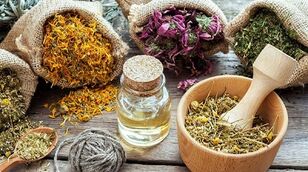
Use the following folk recipes effectively:
- Lubricate the back of the burdock leaf with honey, apply on the affected area, fix with cellophane film and insulate. Keep the compress for up to 4 hours.
- You can use cabbage leaf instead of burdock. You can knead it with your hands or prick it in several places. Honey is optional.
- For internal use, you can use a tincture of burdock root. The raw materials should be finely chopped, steamed with boiling water and insist. Drink a tablespoon 5 times a day.
- Rinse the potato sprouts, place in a glass jar and cover with alcohol. Stand in the dark for 3 weeks, strain and use three times a day to rub the affected areas.
- Heat the honey in a water bath to a liquid state and rub into the affected knee, massaging it. Cover the treated area with gauze or a bandage and insulate. The procedure is repeated every day for a week and a half.
- Steam 5 tbsp. l. rolled oatmeal and cook for 5-8 minutes on low heat. Wrap the cooled mixture in a natural towel, apply to the affected area and fix with polyethylene. Each time you need to prepare a fresh mixture.
- Mix iodine evenly with honey and glycerin, leave for 3 hours. Dip a cotton swab into the resulting composition and treat the knee and adjacent area with movements from bottom to top.
- Chop the garlic head and add a cup of vegetable oil. Insist for a week in the dark, strain and apply on the affected areas before bedtime.
- Grind white school chalk and mix with yogurt or sour cream to make a thick paste. Wrap it in natural fabric and make a compress for 2, 5 hours, insulating it with polyethylene. Repeat the procedure every day.
- Boil two large peeled onions in a liter of distilled water, drain. Drink the resulting infusion three times daily before meals.
The treatment of gonarthrosis should not be limited to traditional medicine. This disease requires an integrated approach, which necessarily includes drug therapy and exercise.
Prognosis, possible complications
The overall prognosis for deforming osteoarthritis is unfavorable due to the progressive nature of the disease. The process of tissue breakdown and joint deformation cannot be reversed, but it can be stopped or significantly slowed down.
The following factors affect the prognosis of gonarthrosis:
- Patient's age.The younger he is, the worse the prognosis. The pathological process develops gradually, due to which with joint damage in young people the disease can reach the last stage to old age and cause various complications.
- Type of osteoarthritis.In primary pathology, only the joint is affected and the disease usually progresses slowly. In secondary disease, there are other disorders that can accelerate this process or provoke complications.
- Observance of doctor's orders.This refers to taking the necessary medications, undergoing physiotherapy procedures, exercise, ensuring unloading of the joint. It is also important to observe the duration of drug therapy, as most drugs must be taken regularly in certain courses.
- Body weight.If the patient is overweight, then the joints experience increased stress, which negatively affects the course of the disease.
- Profession.This factor is very important for the prognosis of the disease. Professional athletes, people under regular stress or constantly on their feet, always suffer more. Sedentary work, when the joint is in one position for a long time, can also negatively affect the course of the disease.
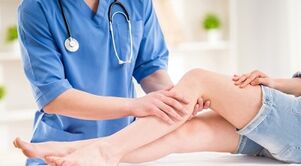
Deforming osteoarthritis progresses slowly, but without proper treatment can cause a number of complications:
- Joint deformity.This happens in the last stage of the disease. The leg can bend at an unnatural angle, which is not only aesthetically unpleasant, but can also cause a complete loss of joint functionality.
- Infection.Microtrauma, for example, a crack in the cartilage tissue, can provoke such a complication. The pathogen can enter the joint along with the current or lymph from the site of infection. Surgical intervention - arthroscopy, diagnostic puncture can also be a cause of infection. Introduction of infections into the joint can provoke aseptic necrosis.
- Dislocation, fracture.Such complications occur against the background of dysfunction of the knee joint, in which the load is not distributed properly and the excess can lead to injury.
- Ankylosis.In this case, the bones at the site of the missing joint grow together. This is one of the most serious disorders, because due to fixing the lower leg in one position, motor function is lost.
In most cases, complications arise through the fault of the patient who has neglected his illness or has disregarded the doctor's orders.
Prevention
To avoid osteoarthritis of the knee, some preventive measures should be taken:
- maintain a normal body weight;
- avoid heavy loads and strong pressure on the knees;
- provide regular and sufficient physical activity;
- avoid joint injuries;
- if an injury occurs, timely, competent and complete treatment is required;
- Strengthen the surrounding muscles.
Secondary prevention measures should also be emphasized. They are needed when gonarthrosis has already been diagnosed and it is necessary to reduce the rate of its development. In this case, you need to take the following measures:
- to resort to a course of chondroprotectors every six months or a year;
- timely, fast and effective treatment of arthritis.
Osteoarthritis of the knee is a serious pathology that has a poor prognosis and can cause a number of complications. It is necessary to start treatment as early as possible to slow down the pathological process. Therapy should be comprehensive, some techniques should become part of the lifestyle: diet, exercise, taking certain medications.



































